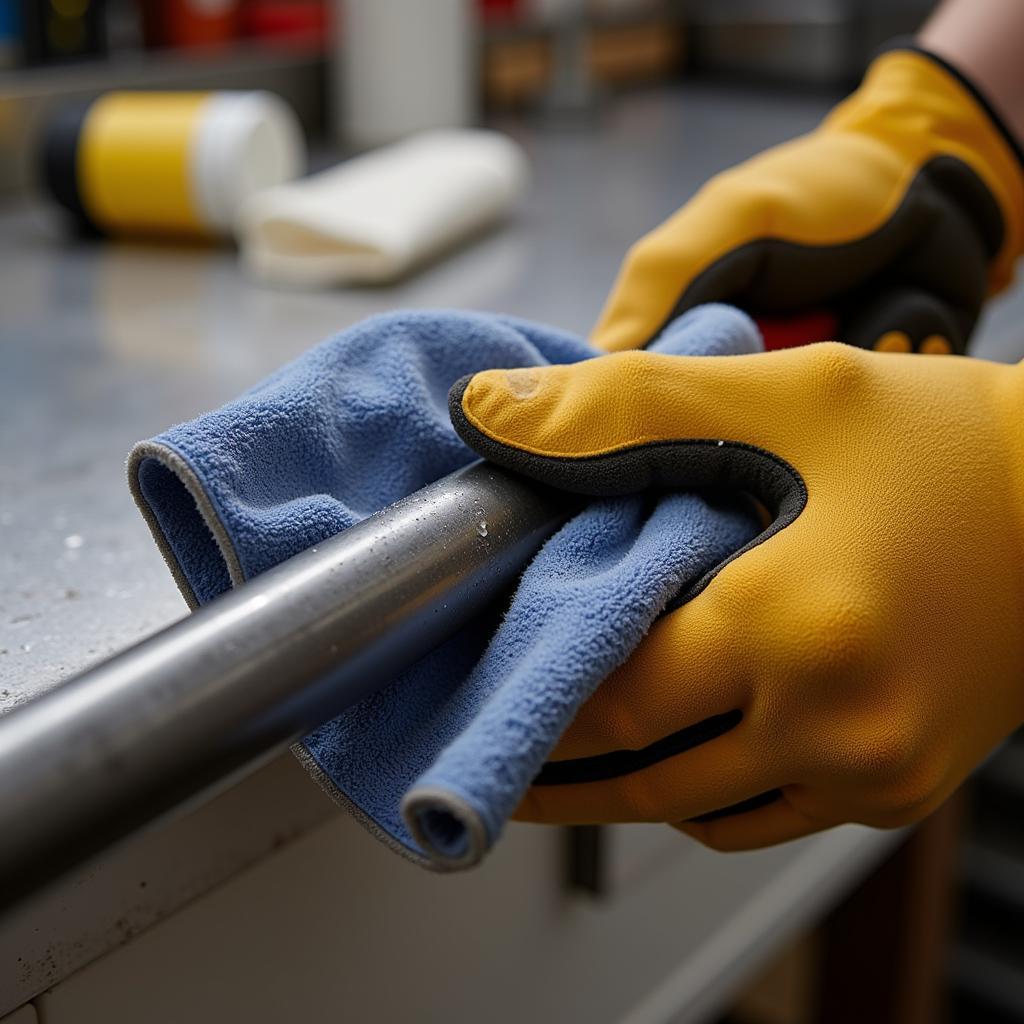Proper Care For A Tool With A Fiberglass Handle Is essential for maintaining its longevity and ensuring safe operation. Fiberglass handles, known for their strength and lightweight nature, require specific maintenance to prevent damage and maximize their lifespan. This article will explore the best practices for caring for your fiberglass-handled tools, from cleaning and storage to identifying and addressing potential problems. After reading this, you’ll be equipped to keep your tools in top condition for years to come.
Why Proper Fiberglass Handle Care Matters
Fiberglass handles are a popular choice for various tools, from hammers and axes to shovels and rakes. Their lightweight design reduces user fatigue, while their strength offers reliable performance. However, neglecting proper care can lead to weakening, splintering, and ultimately, handle failure. This not only compromises the tool’s effectiveness but also poses a safety risk. Regular maintenance ensures the handle remains strong, preventing accidents and extending the tool’s life.
 Cleaning a Fiberglass Tool Handle
Cleaning a Fiberglass Tool Handle
Cleaning Your Fiberglass Handles: A Simple Guide
Cleaning your fiberglass handles is a straightforward process. Regular cleaning removes dirt, grime, and sap, which can degrade the handle over time. Simply wipe the handle down after each use with a damp cloth. For more stubborn dirt, a mild detergent solution can be used. Avoid harsh chemicals or abrasive cleaners, as they can damage the fiberglass. Rinse thoroughly after cleaning and allow the handle to dry completely before storing. This simple routine will significantly extend the lifespan of your tools.
How Often Should You Clean Your Fiberglass Handles?
Ideally, cleaning your fiberglass handles after each use is the best practice. This prevents the buildup of dirt and grime, making future cleaning easier and more effective. However, if you’re using the tools for extended periods, a quick wipe down during breaks can also be beneficial.
Storing Your Fiberglass Handled Tools: Best Practices
Proper storage is just as important as cleaning when it comes to fiberglass handle care. Store your tools in a dry, cool environment away from direct sunlight and extreme temperatures. Avoid leaning tools against walls or other objects where the handle could be subject to pressure or impact. Hanging tools is often the best option, as it minimizes the risk of damage.
 Effective Storage Solutions for Fiberglass Tools
Effective Storage Solutions for Fiberglass Tools
What to Avoid When Storing Fiberglass Handles?
Avoid storing fiberglass handles in damp or humid locations, as this can lead to weakening and deterioration. Also, avoid storing them where they could be exposed to chemicals or solvents, which can also damage the fiberglass. Finally, avoid stacking heavy objects on top of fiberglass handles, as this can cause cracking or deformation.
Inspecting for Damage and Addressing Issues
Regularly inspect your fiberglass handles for signs of damage, such as cracks, splinters, or fraying. If you notice any damage, address it immediately to prevent further deterioration and ensure safe use. Minor cracks can sometimes be repaired with epoxy resin designed for fiberglass. However, for more significant damage, replacing the handle is often the safest and most effective solution.
What are the Signs of a Damaged Fiberglass Handle?
Common signs of a damaged fiberglass handle include visible cracks, splintering, or fraying. You may also notice a change in the handle’s flexibility or strength. If the handle feels unusually weak or bends excessively, it’s a clear indication of damage.
Extending the Life of Your Fiberglass Handles: Pro Tips
There are a few additional steps you can take to further protect and extend the life of your fiberglass handles. Applying a protective coating, such as a clear sealant, can help shield the fiberglass from UV rays, moisture, and other environmental factors. You can find quality garden care tools, including those with fiberglass handles, at essential garden care tools. Additionally, avoid using excessive force when using tools with fiberglass handles, as this can put undue stress on the handle and increase the risk of damage. For those interested in automotive tools, check out our article on china car hammer tool.
Expert Insight from John Miller, Mechanical Engineer: “Fiberglass handles are incredibly durable, but proper care is essential. Regular cleaning and inspection will prevent most common problems.”
Expert Insight from Sarah Johnson, Materials Scientist: “Protecting your fiberglass handles from extreme temperatures and direct sunlight will significantly extend their lifespan.”
Conclusion
Proper care for a tool with a fiberglass handle is a small investment that yields significant returns. By following the tips outlined in this article, you can ensure your fiberglass-handled tools remain strong, safe, and functional for many years to come. Remember, regular cleaning, proper storage, and prompt attention to any damage are key to maximizing the lifespan of your valuable tools. For a longer reach with your tools, consider a car washing pole handle extension northern tools.
FAQ
- Can I use bleach to clean fiberglass handles? No, avoid using bleach or other harsh chemicals, as they can damage the fiberglass.
- How do I repair a severely damaged fiberglass handle? For significant damage, replacing the handle is usually the safest option.
- What’s the best way to store long-handled tools with fiberglass handles? Hanging them is often the best solution to minimize stress and damage.
- Why are fiberglass handles lightweight? Fiberglass is a composite material that offers a high strength-to-weight ratio.
- Are fiberglass handles resistant to rust? Yes, unlike metal handles, fiberglass handles are not susceptible to rust.
- Can I paint a fiberglass handle? Yes, but ensure the paint is compatible with fiberglass and follow the manufacturer’s instructions.
- What are the advantages of using fiberglass handles over wooden handles? Fiberglass handles are more durable, resistant to weathering, and generally require less maintenance than wooden handles.
Need help with your car diagnostics? Contact us via WhatsApp: +1(641)206-8880, Email: [email protected] or visit us at 910 Cedar Lane, Chicago, IL 60605, USA. Our 24/7 customer support team is ready to assist you.

Leave a Reply